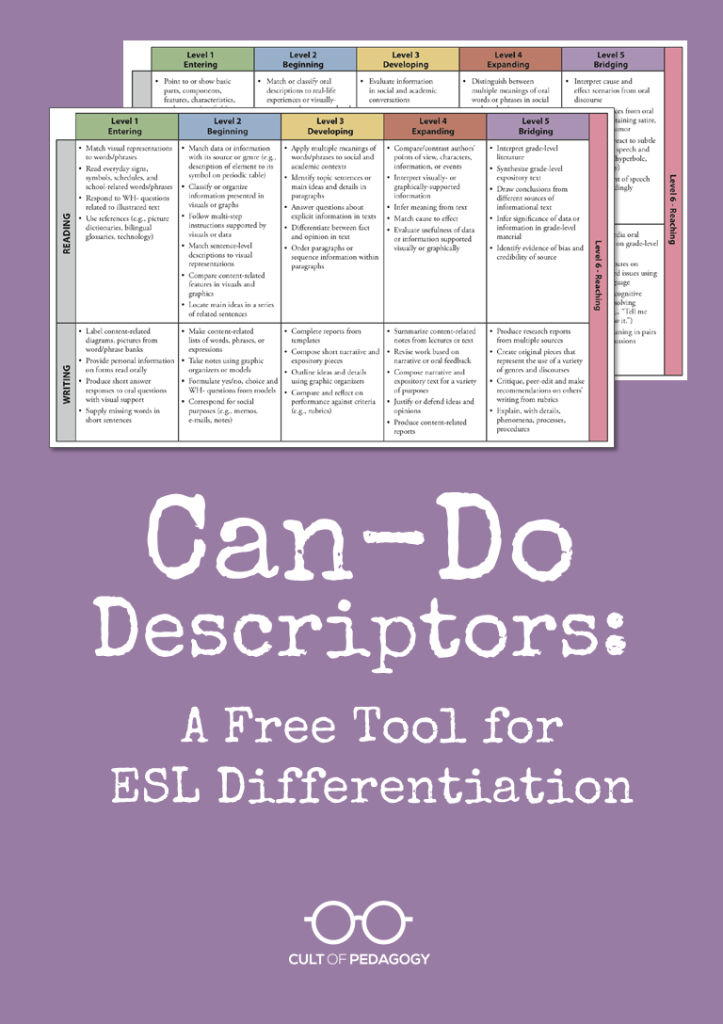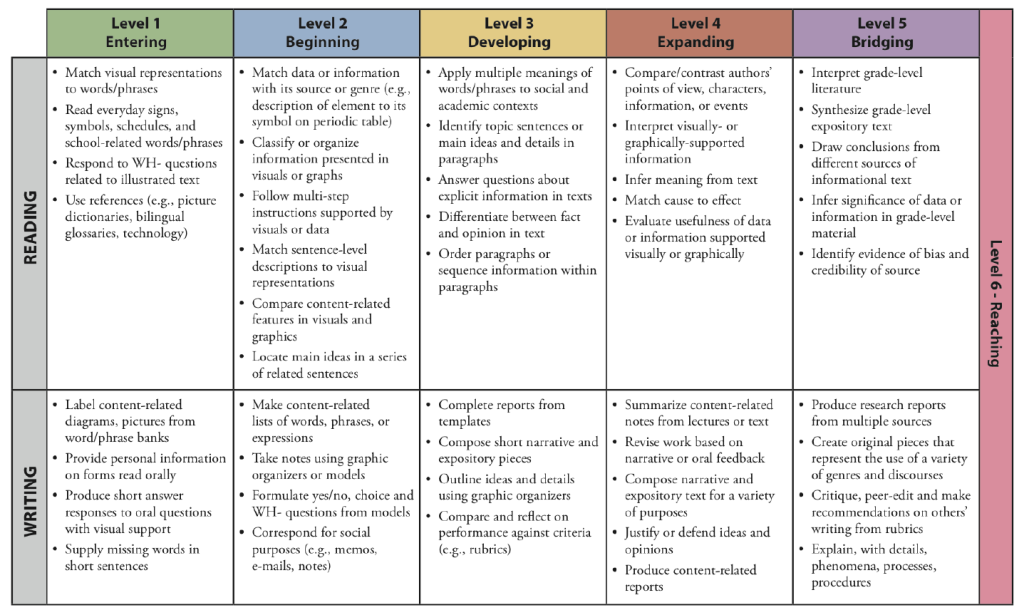
Every year, in classrooms all over the country, the population of English language learners continues to grow. Depending on where you live and how far along your school’s ESL program is, you may have to figure out how to help non-English speaking students participate in your class, even if you have no ESL training yourself.
Sadly, many teachers in this situation will just have these students sit there, watching as their classmates engage in learning activities. Or we might give students a coloring page, just so they have something to do with their hands. It’s not even close to ideal—we know this—but with no other tools at our disposal, what else is there?
In an earlier post, I shared 12 strategies regular classroom teachers can use to support ESL students in their classrooms. If you haven’t read that, definitely check it out. Since then, I have been shown one more tool that can make a huge difference for these students: the Can-Do Descriptors, downloadable for free from an organization called WIDA.
These descriptors are designed to help classroom teachers understand what students at different levels of English proficiency should be able to do in a regular content area classroom. The tasks are separated into four domains: reading, writing, speaking, and listening. The descriptors can help you look at an activity you plan to do with your English-speaking students, then scale it back for ELL students so that they are still interacting with the academic content, just at a simplified level.
How the Can-Do Descriptors Work
Let’s walk through an example so you can see the Can-Do charts in action. Take a look at this page of descriptors for grades 9-12:

Suppose you want students to write research reports that integrate information from a variety of sources. If you look at the “Writing” row on the chart above, you’ll see that this activity is listed as something a Level 5 student should be able to do. Let’s assume you have three ELL students in your class: Seda, who speaks almost no English (Level 1), Pavlo, whose English is progressing, but still hasn’t reached proficiency (Level 3), and Ife, who is approaching fluency (Level 5).
Ife can most likely do the research report as assigned (see the top bullet in “Writing” under Level 5). She may need a bit of help with some of the vocabulary, but at level 5, her proficiency is strong enough to do the same work as her English-speaking peers. Pavlo, at Level 3, could be given a template or graphic organizer that asks for specific information about his chosen topic. In order to complete this template, he will still need to do research, but he won’t need to rely on the advanced English skills required to compose a well-written report. Meanwhile, Seda may only be able to label pictures of items related to a topic similar to those students are researching. If all students are researching careers, for example, you might find out what types of jobs Seda is interested in, have her choose one, then give her pictures related to that job to look up and label.
Here’s another example from 3rd-grade teacher Kelsey Davis, using the grades 3-5 descriptors:
What If You Don’t Have Access Scores?
The levels in these charts are based on student scores on the ACCESS test, which is given in many states to measure English language proficiency. If your state doesn’t use this test, if you are outside of the U.S., or if you are working with a student who hasn’t been tested yet, use these charts as a guideline: The point is to use the descriptors to challenge each student as much as possible within their current language abilities, so make your best guess about what the student might be able to do, try it, and adjust as necessary.
It sure beats having them sit and color. ♦
Download a Free Copy of the WIDA Can-Do Descriptors for your target age group HERE. And check back later: WIDA is currently working on additional versions of the descriptors, including a set in Spanish.
Join our mailing list and get weekly tips, tools, and inspiration that will make your teaching more effective and fun. You’ll get access to our members-only library of free downloads, including 20 Ways to Cut Your Grading Time in Half, the e-booklet that has helped thousands of teachers save time on grading. Over 50,000 teachers have already joined—come on in.





Thank you for this useful post. As an EAL teacher I enjoy all of your work, so I hope you continue to share! I work at an IB school with a concept driven curriculum. I like the WIDA descriptors but I would love to see one addition to them. If we are asking students to write research reports that integrate information from a variety of sources, in a subject like Humanities for example, we need to be able to find a way that they can do that regardless of their level of English. Otherwise, we are dumbing content down and not putting the same expectations on them. For a research report, we could ask students to write in their home language or we should consider differentiating the assessment in a way that all students can still show understanding. Regardless of language, I want to know if my students can do more than just ‘label pictures’, if that makes sense! I wrote a blogpost about what I mean here: http://languageandliteracyforlearning.blogspot.com/2016/01/dont-dumb-it-down-deep-learning-with.html
What are your thoughts on this?
Marcelle, I just finished reading your thoughtful post and I absolutely loved it. Anyone who is working on refining these practices should go over and read it. The Can-Do descriptors were likely developed before the widespread use of Google Translate, so I’m thinking the alternative you describe in that post wasn’t something that WIDA considered. I think the most important thing is to get to know the abilities of the individual student, and gently, persistently push for more challenging activities. If a student is highly literate in their first language, using those same skills on a task like the one you describe would be appropriate. And any time a teacher starts to feel that they are dumbing down their curriculum to the point that it’s not serving the student, they should try something else. The alternative you describe in your post should definitely be a consideration. Thank you so much for sharing!
As a special educator who is always trying to find the appropriate challenge when differentiating, I like your idea about maybe having students do a research report in their mother tongue instead of labeling pictures.
But I’m curious, how can the teacher give them feedback through the learning process. I have worked with many students in several content areas on research reports and it takes a lot of comments on my part, mini-lessons, etc. to help them get the hang of reliable sources, how to create a thesis, organizational structure, how to cite a source, etc.
ps. I forgot to mention that my absolute favourite article you wrote was the one about finding your Marigold! That term is used widely at our school now. So inspirational and so true!
That is so wonderful to hear, Marcelle! I love knowing people are using the term; I think it’s a good step toward building more awareness of how we impact the other teachers around us! Thank you so much.
Thanks for the post (and related posts) regarding ESL students and ways to reach them and hold them to high expectations in the classroom. There’s a lot to think about here, and with more and more full-time inclusion of ESL (fewer pull-outs) in my state at least, we have to think like ESL teachers for our students in order to meet their needs. Useful info! Thanks!
You’re welcome, Laura!
First time teching ESL k-8. Need help evaluating my students,
I will appreaciate any advise, help that you can give me.
Hey there! I’ve been using this chart for some time now and I love it. It gives a quick snapshot for those who teach our ELLs but sadly, are not that interested in all the details we have to share. This document opens the door for that conversation! With that, do you have or know of an updated version that utilizes the ACCESS 2.0 info, and includes the Can Do Descriptors and Key Uses? I would love to introduce the most recent version this school year. Thanks!
Hi, Timothea! This is Holly, a Customer Experience Manager. Cult of Pedagogy doesn’t have a chart based on ACCESS 2.0, but our team found this page with downloadable resources: WIDA: Can Do Descriptors. Hope this helps!
I couldn’t agree more with what you have to say in this post-it is so true-these kids get side-lined and having a way to prove what they CAN do would set them up as equals with valid and valuable contributions to make. Thank you for sharing this tool as it will definitely be a resource I use with my students.
WIDA no longer offers the descriptors as a free download.
Oh no. Thanks for the update, Marla.
Hi, Marla! I was able to find free downloads of the Can-Do Descriptors either from links in Jenn’s post or by directly going to WIDA. It does appear that there’s an option to purchase spiral bound versions as well. Hope this helps!
I need help with some ideas of how can can do descriptors help with planning an ela lesson on writing.
Hi Cathy,
Be sure to take another look at the section called How the Can-Do Descriptors Work. This section discusses how a teacher takes a planned lesson, and then differentiates or scales back for ELL students based on what they can currently do. There’s really no need to plan an entirely different lesson. I also suggest checking out 12 Ways to Support English Language Learners in the Mainstream Classroom for some really helpful tips.
Hi, Jen. Thank you for writing this post. I love the language of the WIDA’s Can Do Descritpros. It focuses on what ELs can do rather than what they can’t.
Emily Francis guest posted on my blog about how she creates several grade-level report cards based on the Can Do Descritpros. The site also offers templates of these for K to 12. Readers have found the templates very helpful.
https://www.empoweringells.com/grading-newcomers/
We recently moved to “can” descriptors to align our English for Academic Purposes program with CEFR and we love them. Instead of “demonstates proficiency in” or “shows understanding of”, our rubrics are set to “can give” and “can identify.” It’s more transparent for the students as well.
Hi, there! Do you know if anyone has done a crosswalk between the MYP Language B Phases and the WIDA Levels? Thanks!
Hey Elaine,
According to WIDA, they have not created any documentation outlining correlations with other language programs. However, seeing as how there are six WIDA levels and six MYP language phases, I think it’s reasonable to assume that you could use the Can-Do Descriptors to help differentiate instruction for language learners in an IB program. In fact, I believe there are many international schools out there that do this. See, for example, ISS Singapore Campus’s ESL Guidelines and Procedures. In Appendix 5 of the document they show a one-to-one correspondence between the WIDA levels and MYP language phases. Hope this helps!
As I embark on a bit of a new journey working with some ELLs next year I find this very detailed article helpful. I delved into the Can-Do descriptors, but having your break it down was what’s up.
Are the Can-Do descriptor scores based on WIDA scores or ACCESS? I have never heard of ACCESS so I was a little surprised to see that part.
Also, you mentioned using the Can-Dos as a guide if you don’t have their language levels. I’m wondering would you guage their levels through observation, work samples, etc.?
Thanks again for the post!
The link for the descriptors needs to be updated.